We asked 1,117 bloggers about their techniques and results to find out what’s working best right now.
In this post, you’ll learn about their top traffic sources, how they make money, which types of blog posts are working best, how they use video & podcasting, and lots more.
Their answers are divided into two groups: bloggers who make $50,000+ per year from their blogs vs. lower-income bloggers.
Let’s start with some highlights.
Contents
Highlights: Key Statistics & Blogging Trends
1. Bloggers who earn over $50,000 per year tend to put a lot of emphasis on SEO. Their #1 traffic source is typically Google organic search, and compared to lower-income bloggers they are 4.3 times as likely to conduct keyword research.
2. Over 50% of bloggers say it has gotten harder to get traffic from Facebook over the past two years, and nearly one-fifth say it has gotten harder to get traffic from Google.
3. Higher-income bloggers rate the importance of social media 19% lower than lower-income bloggers do.
4. 70% of bloggers who earn over $50,000 per year say they are active or very active promoters of their blogs, compared to only 14% of lower-income bloggers.
5. “Quality of content” is rated the #1 most important success factor among all bloggers. However, higher-income bloggers also put much more emphasis on promoting their content than lower-income bloggers do.
6. The most common reason for blogging is making money, with two-thirds of all bloggers naming it as their main motivation.
7. Google AdSense is the most popular monetization method bloggers use, followed by affiliate marketing. But for higher-income bloggers, AdSense ranks third: they are 2.5 times as likely to sell their own product or service as they are to use AdSense.
8. 45% of bloggers who earn over $50,000 per year sell their own product or service, while only 8% of lower-income bloggers do.
9. The most common challenge bloggers face is getting traffic to their blogs.
10. Compared to lower-income bloggers, bloggers who earn over $50,000 per year are:
- 5.8 times as likely to publish case studies
- 5 times as likely to have a podcast
- 4.5 times as likely to publish video
- 3.7 times as likely to publish interviews
11. Bloggers who earn over $50,000 per year from their blogs are over twice as likely to focus on getting email subscribers as lower-income bloggers are. They also use 343% as many email-collection methods as lower-income bloggers.
12. Successful bloggers know their audiences well. 73% of bloggers who earn over $50,000 per year say they focus their content on the interests of a very specific group.
13. Bloggers who earn over $50,000 per year pay content writers 3.6 times as much as lower-income bloggers do.
14. Longer articles are correlated with success. Bloggers who earn over $50,000 per year say their most popular blog posts are 2,424 words long on average: 83% longer than those from lower-income bloggers.
Keep reading for more detailed blogging statistics and charts.
Or click here to download a PDF of the full report, including a private bonus chart of the top things higher-income bloggers do differently.
How Bloggers Rate 10 Different Success Factors
Bloggers who earn over $50,000 per year place a bigger emphasis on article headlines & introductions, SEO, email marketing, site design, blog name & URL, and relationships with influencers than lower-income bloggers do.
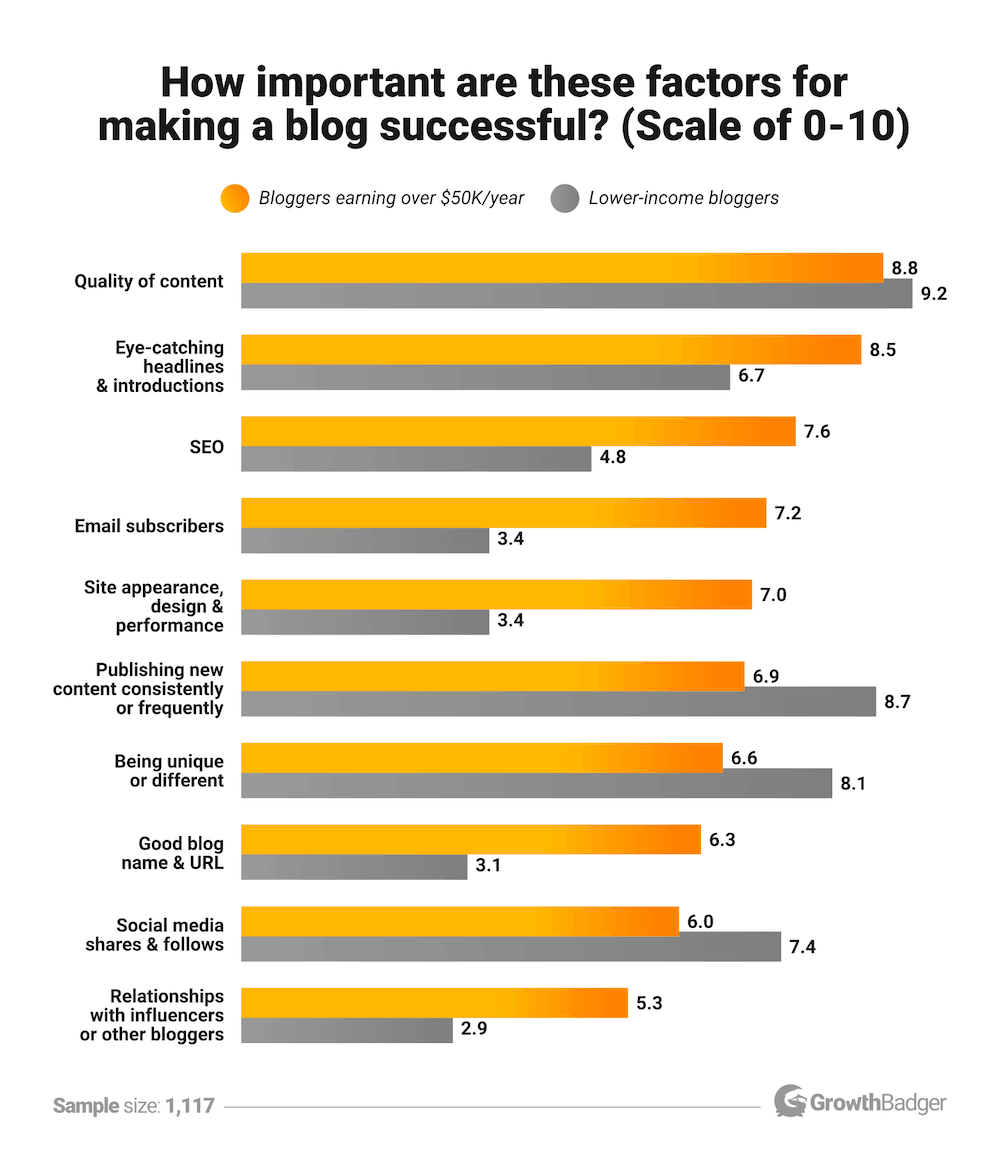
On the other hand, lower-income bloggers focus more on social media, content-publishing frequency, and “being unique or different”.
(As we’ll see later, however, higher-income bloggers actually put more emphasis on developing content for specific, narrow audiences.)
This is the beginning of a pattern we’ll see come up again in other charts: lower-income bloggers tend to focus almost exclusively on the quality and quantity of content they publish and hope that it spreads organically. While higher-income bloggers tend to more actively promote their content and optimize it to be shareable.
Expert opinions:
Pete McPherson, Founder of Do You Even Blog:
“I’m not surprised at all that higher-income bloggers rate email as so much more important than lower-income bloggers do. I would probably give it an 8 or a 9 myself. It’s extremely important, if only for the concept of tribe-building: tribes over traffic. The email list is still the best place by far to congregate that following, as of right now.
I’m actually surprised there isn’t a bigger gap between higher-income and lower-income bloggers when it comes to ‘publishing new content consistently or frequently.’ I would’ve thought bloggers earning over $50K per year would’ve rated it much lower: maybe closer to 4 or 5. I have found that it just does not translate into growth as much as we all think it should. When you’re brand new, I can see it. But as far as higher-income bloggers, I’m really shocked. It gets a 3 or 4 in my book.”
Tom Zsomborgi, CFO of Kinsta:
“It’s not surprising that higher-income bloggers rate ‘site appearance, design & performance’ more than twice as high as lower-income bloggers do. Because once you have enough traffic, things like design changes, 2 seconds faster load times or a well designed CTA can make thousands of extra dollars each month.”
Justin Cooke, CMO & Founder of Empire Flippers:
“There is value in a solid domain name, but I hesitate to put TOO much emphasis on it. It seems to be a spot early-stage entrepreneurs get caught-up or stuck. (That and setting up the legal entity.) Both of those areas are sticking points that often keep people from moving forward. It’s better to have a TERRIBLE domain and continue to move forward than to spend the next 3-6 months trying to find something and never getting started, if that makes sense!”
What Other Forms of Media or Content Marketing Are Most Effective in Support of a Blog?
The highest-earning bloggers do more than just blog. They also use other types of content marketing.
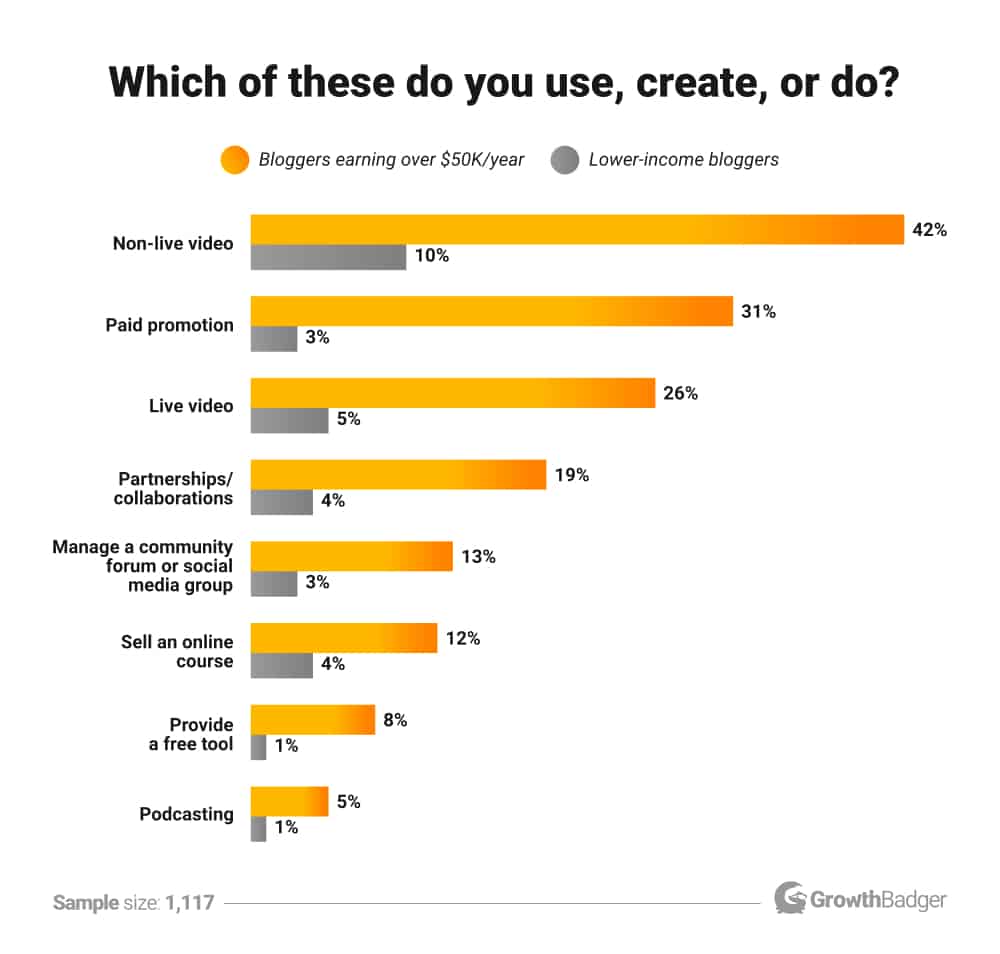
Higher-income bloggers publish video, use paid promotion, and collaborate with others much more frequently than sub-$50K earners do.
They tend to act like content marketers rather than solely as bloggers.
While the first chart showed us that lower-income bloggers tend to focus on the content alone, this chart shows that they also tend to stick to the format of written blog posts — while higher-income bloggers follow a trend of branching out into multiple content formats.
Major takeaways:
- Higher-income bloggers use paid promotion 10.3 times as often as lower-income bloggers do.
- Compared to lower-income bloggers, bloggers who earn over $50,000 per year are more than 4 times as likely to use video, 8 times as likely to provide a free tool, and 5 times as likely to have a podcast.
Expert opinions:
Brian Dean, Founder of Backlinko:
“I’m not surprised at all by this stat. The simple fact is this: non-live videos are expensive to make. And it’s something that makes sense once you’ve established your blog and a consistent publishing schedule.
(In other words, when you stop being a ‘lower-income blogger’.)
So my take isn’t that moving towards non-live video will make you a baller blogger. In fact, the opposite. Video is a ‘nice to have’ luxury that established bloggers should tap into. Until then, you’re better off working 100% on your text-based blog content.”
Ai Addyson-Zhang, Ph.D, Founder of Classroom Without Walls:
“I have been running a weekly live streaming show for almost two years now. I cannot emphasize enough the importance of producing live video and video content in general to grow one’s community, brand, and influence. I recently came back from Social Media Examiner’s annual social media marketing conference in San Diego. My biggest takeaway after hearing all the keynote sessions was to produce more video content. I recommend all the bloggers give video content a try. I repurpose my live streaming interviews into blog articles. But there can be so many creative ways to build connections between written and video content.”
How Bloggers Get Email Subscribers
Bloggers who earn over $50,000 per year from their blogs use every type of email-collection tactic we asked about more often than lower-income bloggers do.
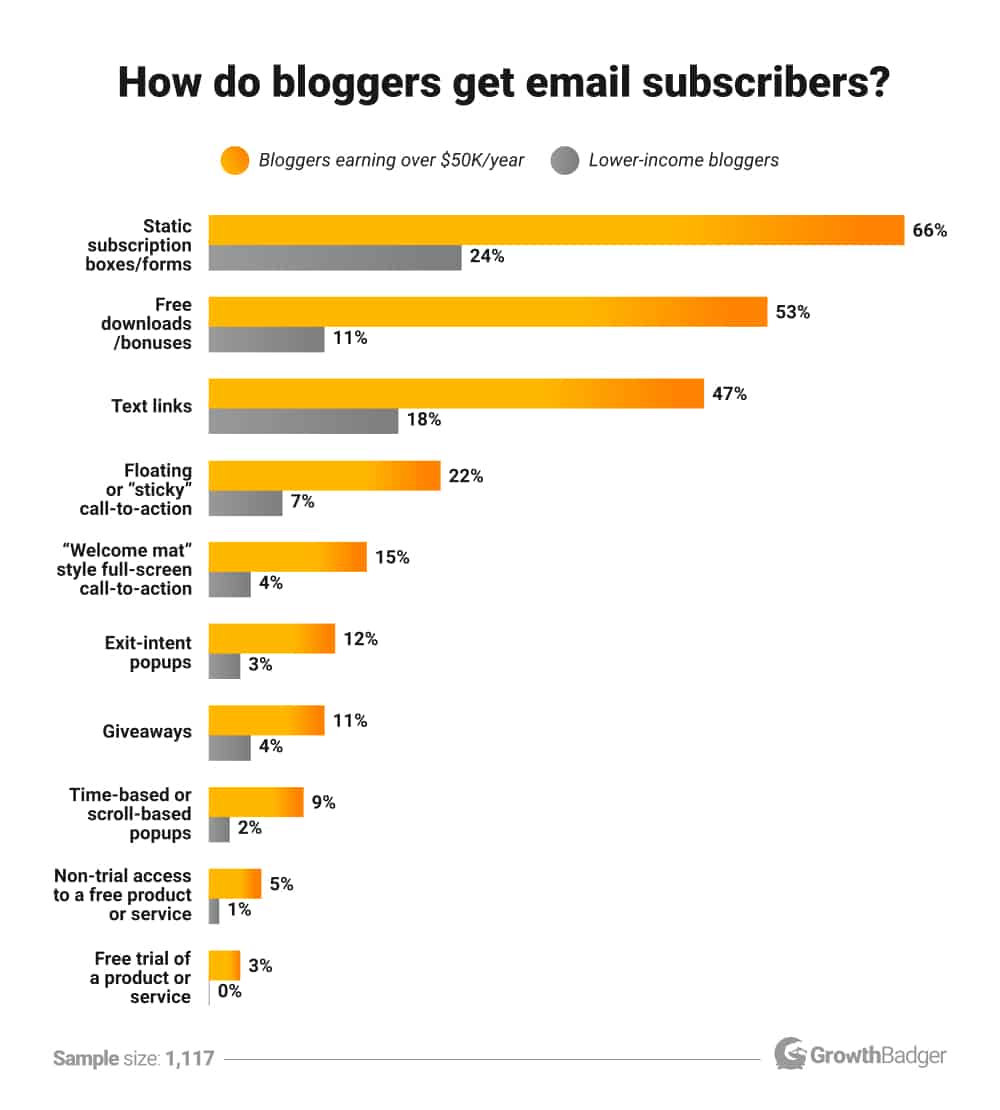
Major takeaways:
- Regular static subscription boxes are the most popular method among all bloggers for collecting email addresses. But bloggers who earn over $50,000 per year use them 2.8 times as often as lower-income bloggers.
- 53% of bloggers who earn over $50K per year offer downloadable bonus content in exchange for email addresses, but only 11% of lower-income bloggers do.
- Higher-income bloggers offer free products and services and/or free trials 700% more often than lower-income bloggers do. (Free tools are a great way to attract backlinks and traffic to a blog.)
Higher-Income Bloggers Use 343% as Many Email-Collection Methods
Blogs that generate over $50,000 per year are also much more likely to use multiple tactics to bring in new email subscribers.
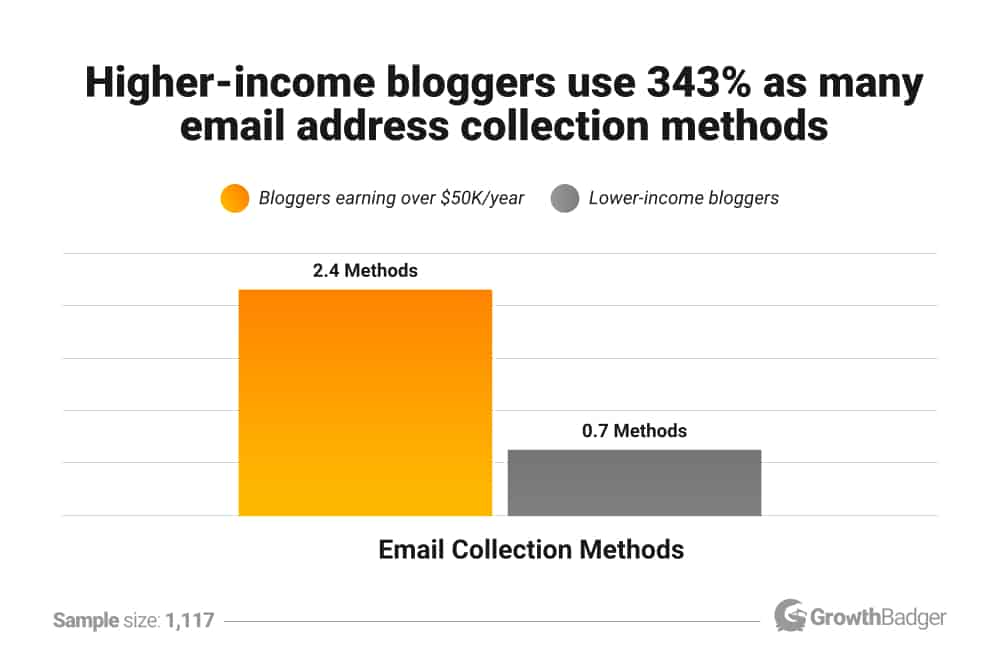
Major takeaway:
- Bloggers who earn over $50,000 per year use an average of 2.4 email address collection methods, while lower-income bloggers use only 0.7.
Expert opinion:
Noah Kagan, Chief Sumo at Sumo, AppSumo & KingSumo:
“This isn’t surprising to me [that higher-income bloggers use 343% as many email collection methods] — of course they do. It’s kind of like saying ‘people who have Mercedes are rich.’ ”
How Much Do Bloggers Focus on Marketing?
We’ve already seen that higher-income bloggers consider several aspects of promotion more important than lower-income bloggers do.
This chart demonstrates that higher-income bloggers are much more focused on marketing and promotion in general than lower-income bloggers are.
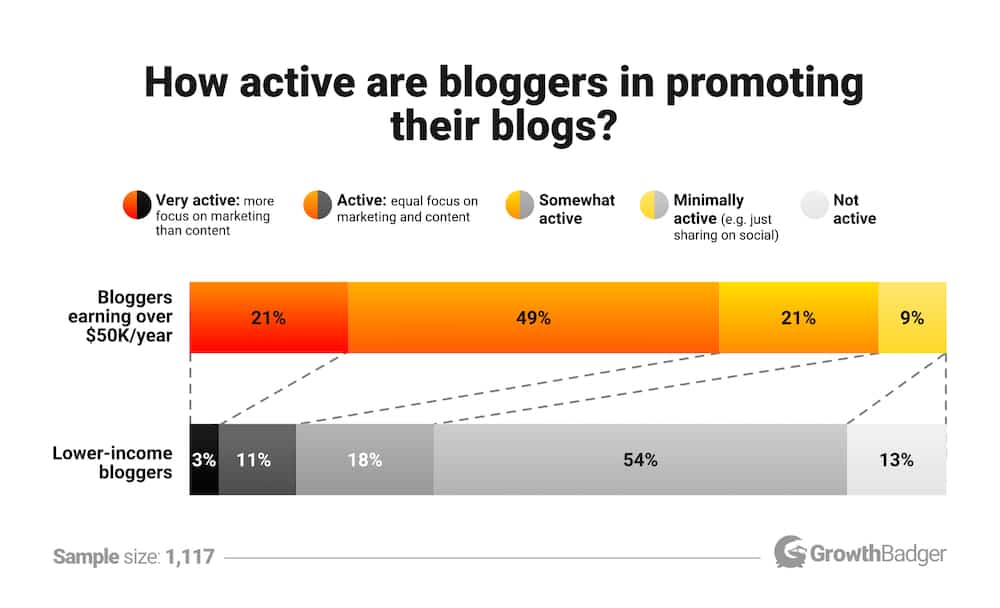
Major takeaways:
- 70% of bloggers who earn over $50K per year from their blogs are active or very active promoters, while only 14% of lower-income bloggers are.
- A full 21% of higher-income bloggers focus more on marketing than on content, while only 3% of lower-income bloggers do.
- 54% of lower-income bloggers said their marketing effort was “minimally active (e.g. just sharing on social).”
Expert opinion:
Harsh Agrawal, Founder of ShoutMeLoud:
“Once a newbie blogger starts making money from blogging, they get more serious. However, when a blogger moves to $20k+ in revenue/month, they realize the higher potential of a blog which is now a dedicated platform in the niche they are in. This is where they start implementing most of those aspects of digital marketing which moves the needle.
The focus generally shifts from doing everything to doing those activities which generate significant results.
For example: Setting up funnels, moving from shotgun marketing to sniper marketing and so on. Since the marketing efforts going to bring more highly targeted traffic to a working product (in this case the blog itself is a bundle of products) which in-turn convert into higher ROI.
This same technique can be applied by bloggers at any level, only if they understand the importance and impact of such re-investment in the business.”
What Are the Best Traffic Sources for Blogs?
This is one of the most important sets of blogging stats we collected, because it shows which traffic sources are the most important for bloggers and content marketers.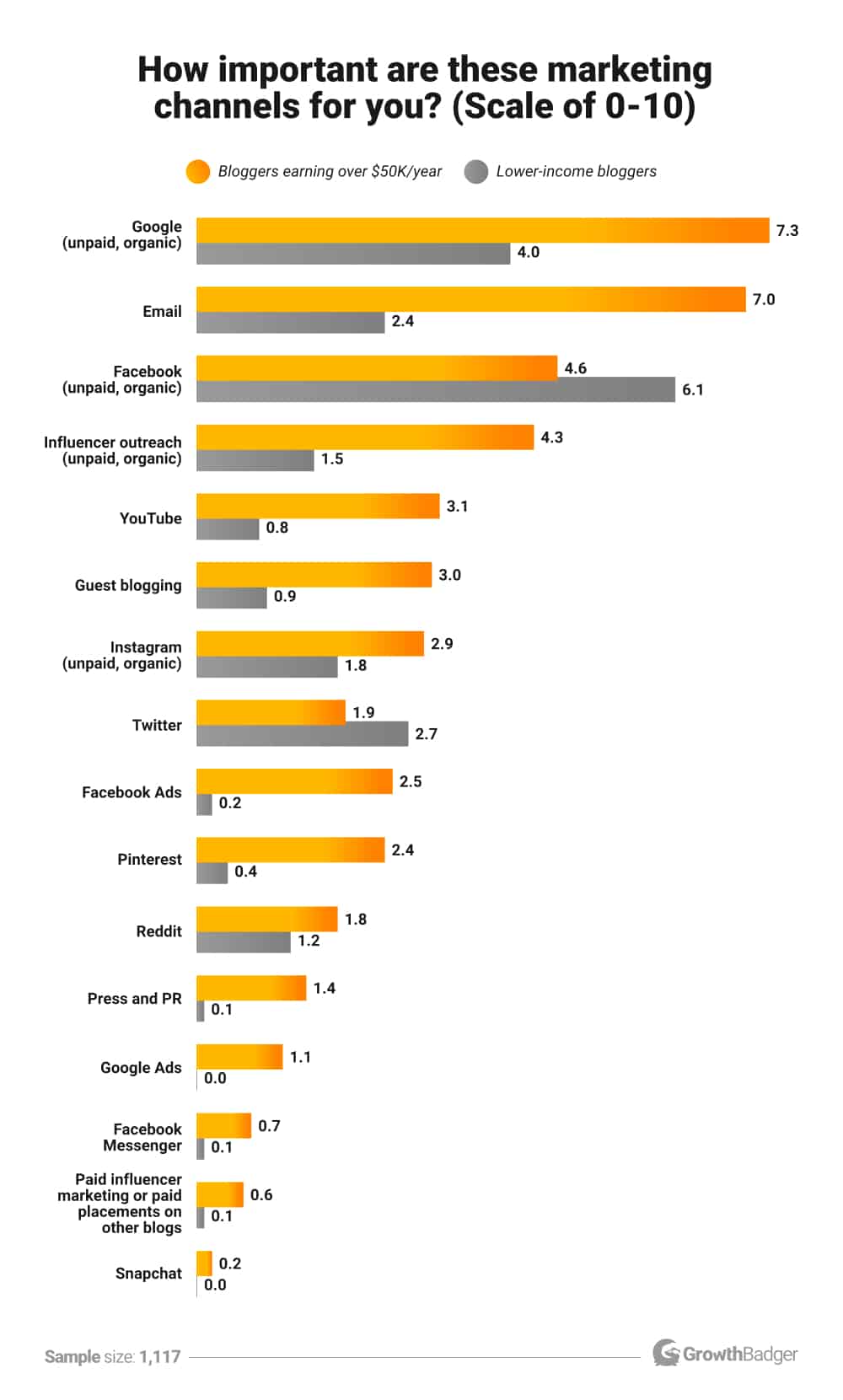
This chart again shows how much higher-income blogs rely on organic search traffic and email, while lower-income bloggers tend to put less emphasis on most marketing outside of social media.
The only two marketing channels that lower-income bloggers rely on more than higher-income bloggers do are Facebook and Twitter.
But higher-income bloggers do put more emphasis on some social networks: specifically YouTube, Instagram, Pinterest, Reddit, Facebook Messenger and Snapchat (though those last two get low scores from both groups).
Major takeaways:
- Bloggers who earn over $50,000 per year take content optimization seriously: they rate Google organic traffic as 83% more important than lower-income bloggers do. And they also rate email marketing 192% more important than lower-income bloggers do.
- Compared to lower-income bloggers, bloggers who make over $50K per year consider YouTube 3.9 times as valuable.
Expert opinion:
Brian Honigman, marketing consultant and Adjunct Professor at NYU:
“My main takeaway from this chart is once you’re generating more revenue from blogging, you’re more likely to find a range of marketing channels useful as they helped make your efforts profitable. Prior to making any noticeable amount of money as a blogger, it’s unclear as to which marketing channels have had an impact as there hasn’t been a noticeable pay off yet. According to this study, ‘low-income bloggers’ find Twitter and Facebook more useful prior to making $50k a year, likely because these are the social networks most commonly used by consumers thus they probably have the most familiarity with how to drive results from them.”
Which Marketing Channels Are Becoming More Important and Which Are Becoming Less Important?
This chart illustrates how the impact of different traffic sources is changing over time.
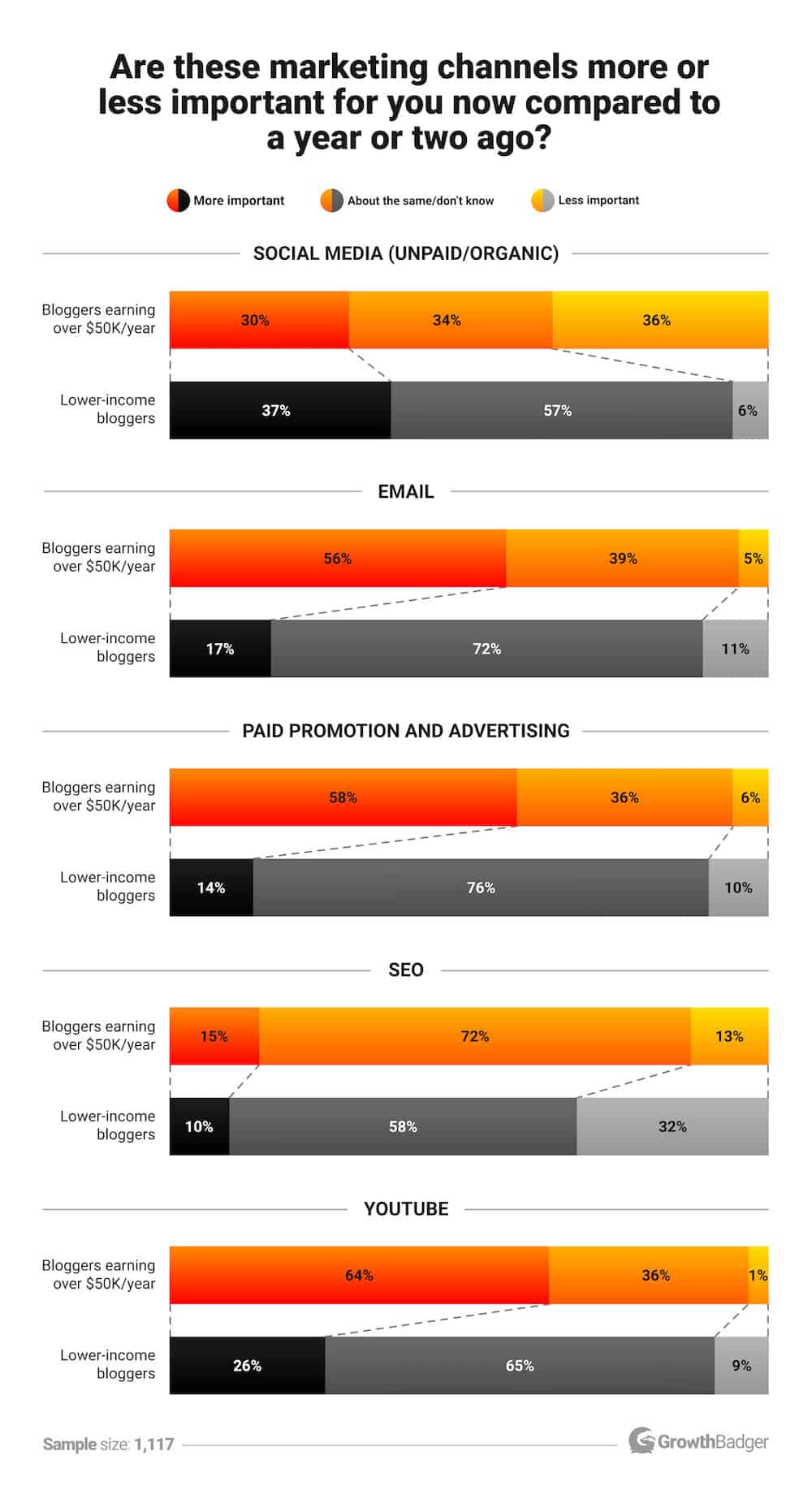
The majority of higher-income bloggers say that email, paid promotion, and YouTube are more important now than they were a year or two ago, while social media is about the same or less important.
Interestingly, although the previous charts have shown that higher-income bloggers consider SEO to be the #1 most important marketing method, 72% of them say it is no more important now than it was a year or two ago.
The majority of lower-income bloggers answered “about the same/don’t know” for every marketing channel.
Major takeaway:
- According to higher-income bloggers: YouTube, paid promotion, and email marketing have all gotten more important in recent years, while social media has gotten slightly less important and SEO has remained about the same.
Which Types of Blog Posts Are the Most Popular and Effective?
There are key differences in the types of blog posts being published by higher- and lower-income bloggers.
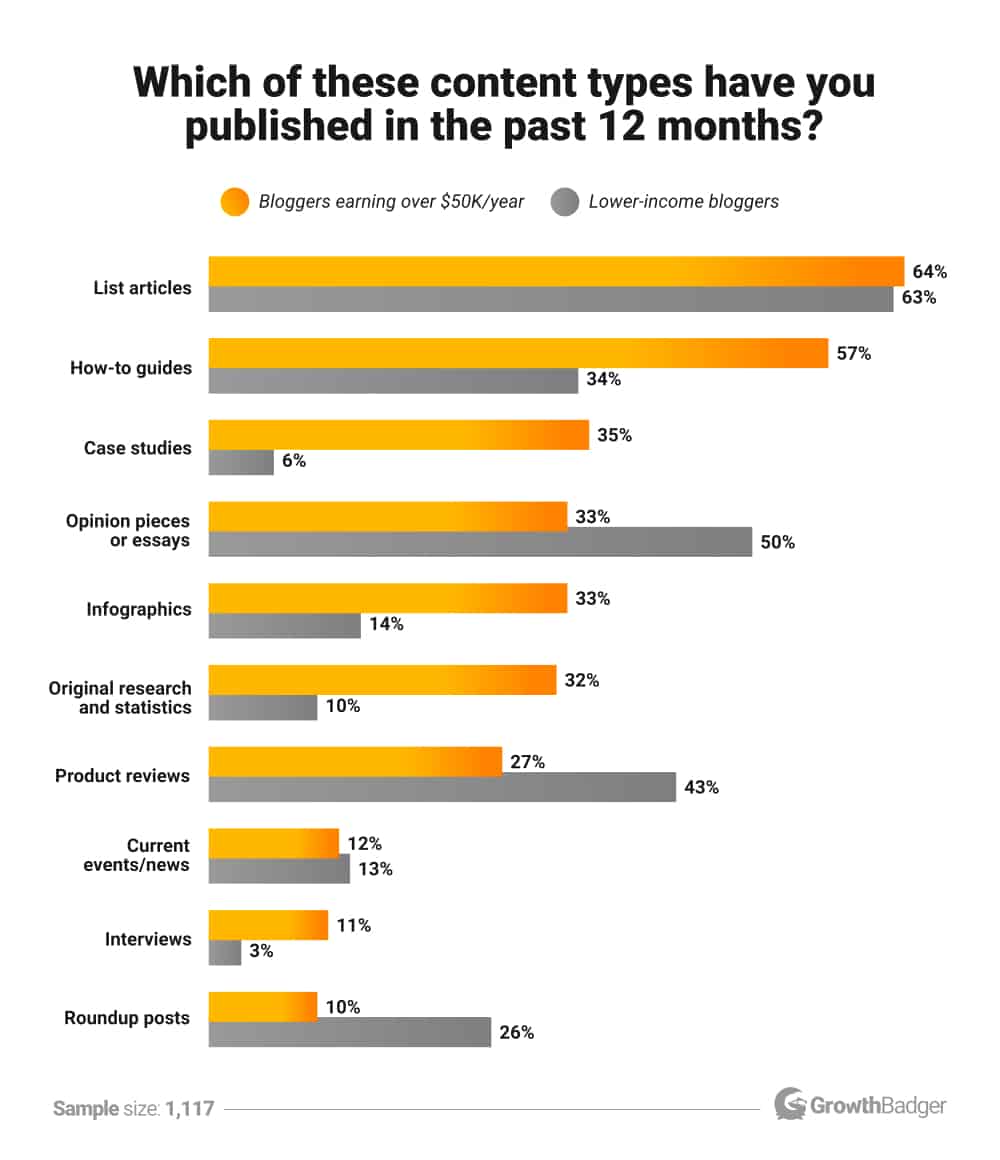
Of all the types we asked about, the most common flavor of blog post is list articles, with about the same percentage of both income levels publishing them over the past year.
But after that, higher-income bloggers tend to favor how-to guides and case studies, while lower-income bloggers publish more opinion pieces and product reviews.
Major takeaways:
- Bloggers who earn $50K or more per year from their blogs are 5.8 times as likely to publish case studies, 3.2 times as likely to publish original research, and 3.7 times as likely to publish interviews compared to lower-income bloggers.
Expert opinion:
Glen Allsopp, Founder of detailed.com and gaps.com:
“I may be generalising things with my response, but I found the roundup posts stat the most interesting, even if it’s completely what I expected.
It’s almost like when people start out blogging they see fellow bloggers as “their people” rather than their audience, because they’re getting involved in this new thing and learning all there is to know. Roundups – and supporting those on the same journey – makes sense in that regard.
Yet when you’re taking your blog to the next level, it’s not surprising to see those become rarer as your people really are your audience, and likely not so much the fellow bloggers in your industry. (That, and I would imagine many give link love within value-giving articles, rather than dedicating content to roundups.)
I was pretty surprised to see list articles to be so common, though they can be done in a very interesting way e.g. talking about 100 items in a list rather than 10. I can’t recall any really interesting ones I’ve come across that were published in the last two years. Great data!”
Average Length of Bloggers’ Best-Performing Posts
While overall average blog post length has been covered elsewhere, this question addresses how long the best-performing blog posts are.
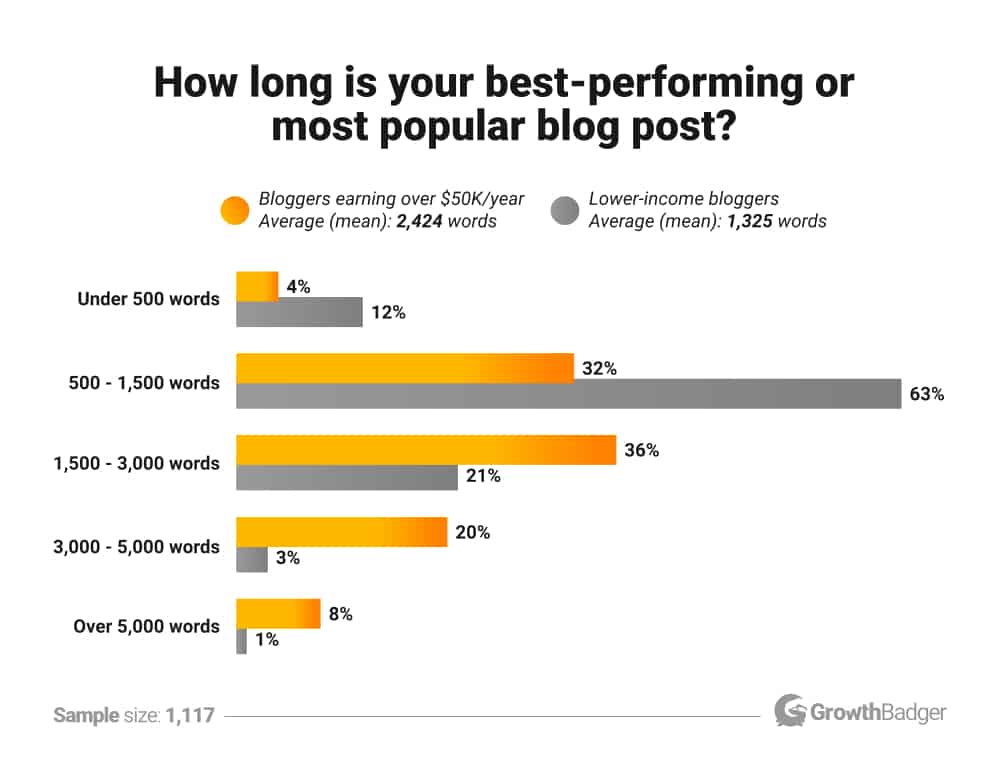
Major takeaways:
- Successful bloggers (earning over $50K per year) said their most popular blog posts were an average of 2,424 words long: 83% longer than the most popular blog posts from lower-income bloggers.
- Compared to lower-income bloggers, bloggers earning over $50K per year are seven times as likely to have top blog posts of over 3,000 words.
How Do Bloggers Research and Decide What to Write About?
Some people do systematic research to decide what topics to write about, while others rely on gut instinct.
Care to guess which is more common among higher-income bloggers?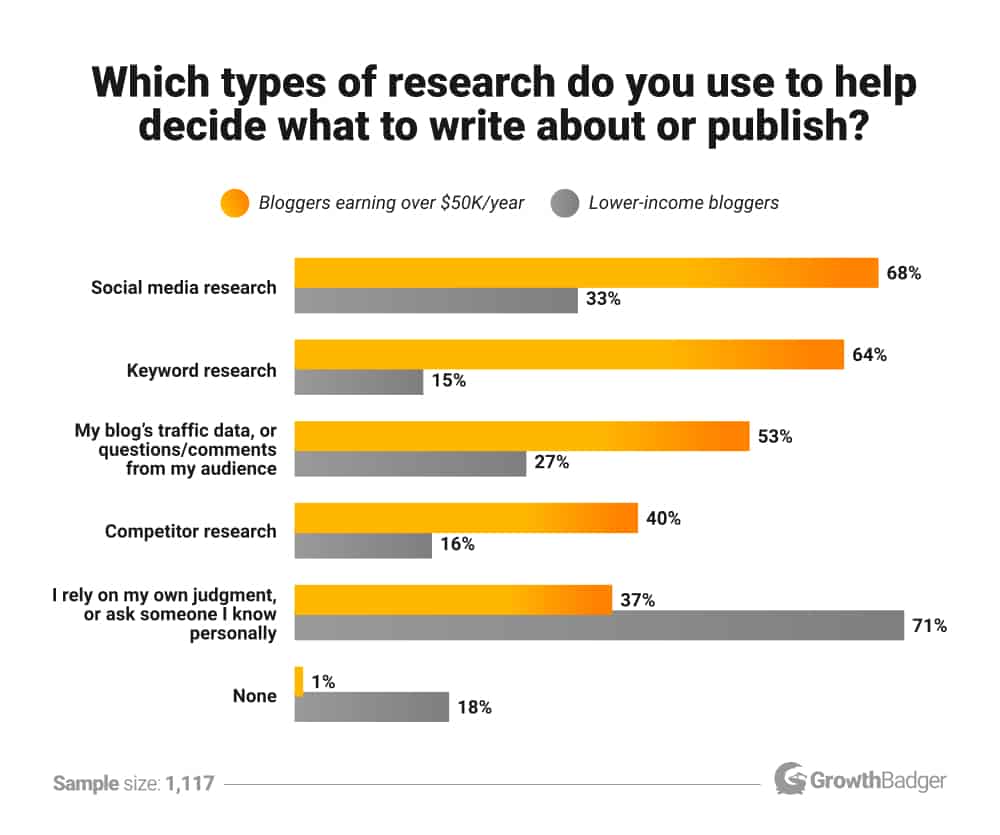
The majority of higher-income bloggers use some form of strategic research to help decide on post topics, while lower-income bloggers do so much less often.
Interestingly, while the answers to several other questions in this study demonstrate that higher-income bloggers favor SEO over social media, those same bloggers use social media research slightly more often than keyword research.
That may be because basic, informal social media research can be done quickly on the social networks themselves, while keyword research typically involves additional tools.
Major takeaways:
- Bloggers who earn over $50,000 per year from blogging are 4.3 times as likely to use keyword research when deciding what to write about or publish. Only 15% of lower-income bloggers do keyword research, but 64% of higher-income bloggers do.
- Social media research is the most common type of research.
- Compared to bloggers who earn over $50K per year, lower-income bloggers are twice as likely to rely on their own judgment or ask someone they know personally.
Expert opinion:
Cyrus Shepard, Founder of Zyppy.com:
“This chart makes me chuckle, because I myself fall in the ‘rely on my own judgment’ research group, which is associated with lower-income bloggers. (In my defense, I know my subject area very, very well.)
On the other hand, this confirms the importance of research when creating content. We see so many great blog posts—while excellently written, informative and/or entertaining—fail to gain traction after initially publishing because they don’t target highly sought topics (either in search or social media.)
My own preferences are keyword+competitive research, as my goal is typically long-term search traffic. Obviously, a huge number of folks find success with social media research, as this is likely a channel from which these bloggers successfully generate traffic.”
Do Successful Blogs Focus on Narrow, Niche Audiences or Try to Appeal to a Wider Group?
1,000 true fans. A meaningful specific beats a wandering generality. An inch wide and a mile deep.
There are plenty of aphorisms about focusing on a specific area rather than trying to appeal to everyone. But do they hold up?
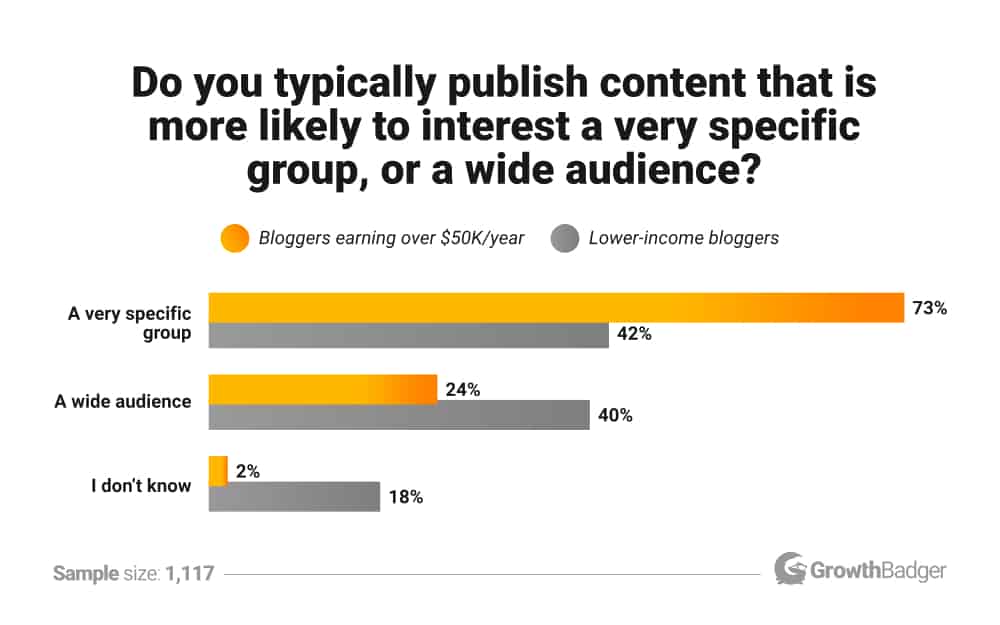
Yes, it looks like they do.
The majority of people earning over $50,000 per year from blogging say they focus on a very specific group, while lower-income bloggers are about evenly split between focusing on a narrow audience or a broad one.
That’s somewhat surprising because in the “success factors” chart at the top of this post, we saw that lower-income bloggers put greater weight into being unique or different than higher-income bloggers do. Perhaps the difference is in the wording: lower-income bloggers strive to be unique, while higher-income bloggers attempt to serve their audiences’ unique needs.
Major takeaways:
- 73% of bloggers who earn over $50,000 per year typically publish content focused on the interests of very specific groups, compared to only 42% of lower-income bloggers who do the same.
- Compared to higher-income bloggers, lower-income bloggers are nine times as likely not to know whether their content is more interesting to a wide audience or a narrow one.
Expert opinion:
Andrew Warner, Founder of Mixergy and Bot Academy:
“I know someone is an amateur when they worry about their audience being too small. It comes from a sense of worthlessness that they want a big number to help them overcome. In reality, finding the right audience is more important.
When other podcasters talk to Mixergy’s ad sales guy they’re shocked and jealous about our high ad rates. The reason we can do that is the Mixergy audience is full of real entrepreneurs with real companies, so advertisers pay more to reach them.”
How Much Do Bloggers Know About Their Audiences?
From the chart above, it appears that having an idea of your audience’s interests can be a big advantage.
But how much detail about your audience is actually useful for blogging?

Higher-income bloggers are much more likely to put deliberate thought into understanding their typical reader or target audience, with over two-thirds of them doing so.
This matches the theme we’ve seen throughout this study: higher-income bloggers are also more likely to place an importance on the name of their blogs, do research on which content topics to target, and use paid advertising — all of which can greatly benefit (and sometimes also lead to) a strong understanding of the audience.
Major takeaways:
- Compared to lower-income bloggers, bloggers who make over $50,000 per year are 213% as likely to have a good understanding of their typical reader and 700% as likely to have detailed notes about their target audience’s goals, attitudes, interests and lifestyle (psychographics).
- 68% of bloggers who make less than $50K per year have not put deliberate thought into who their target audience is.
Expert opinion:
Dorie Clark, author of Entrepreneurial You, Reinventing You, and Stand Out:
“The more a blogger understands their target audience, the more relevant content they can create. That enables a virtuous circle, in which readers keep coming back, and will have increased trust in the bloggers’ recommendations for other products and services.”
How Much Do Blog Owners Pay Content Writers?
Many bloggers write all their own content and do not hire writers at all. But of those that do outsource their article writing, we thought it would be interesting to see how much they pay per article.
First, here is the distribution of answers:
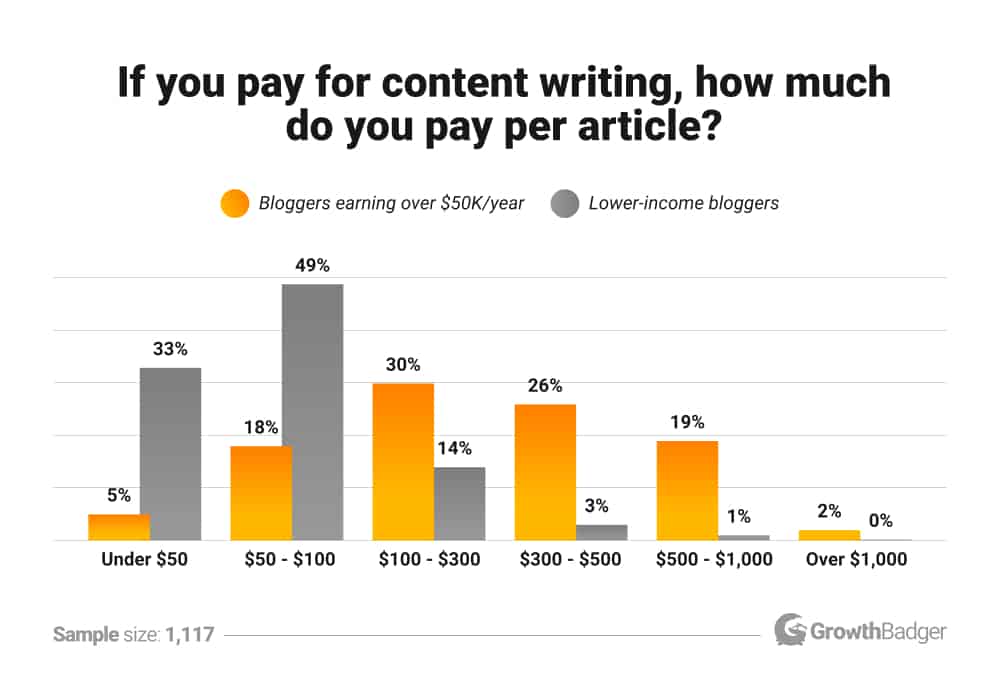
As you might expect, higher-income bloggers typically pay more than lower-income bloggers do.
What’s more surprising is just how big the gap is:
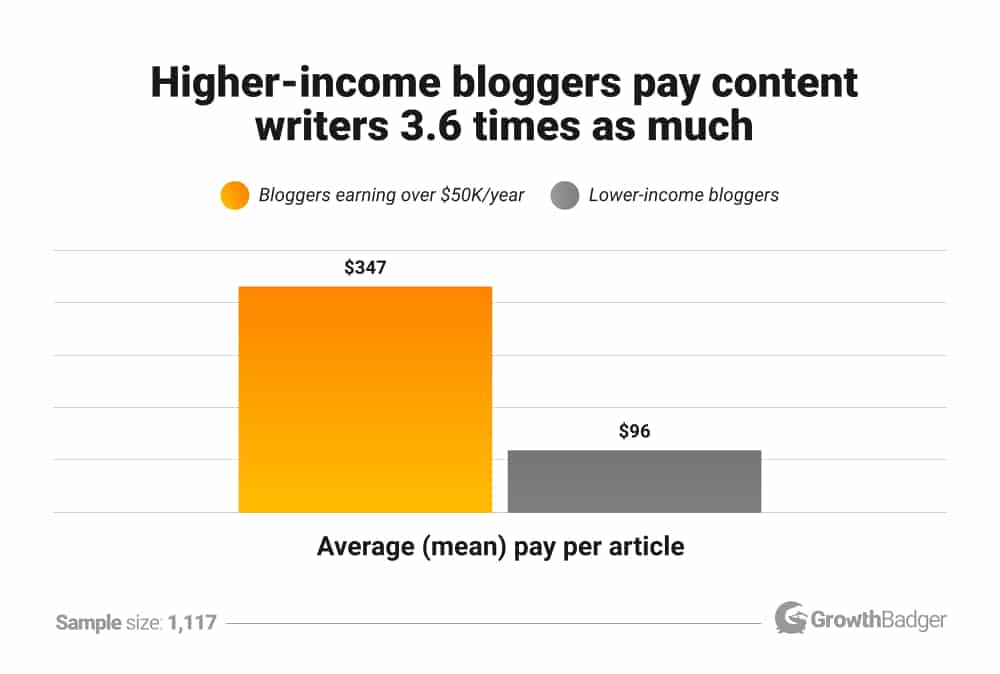
If you Google “how much money do freelance writers make,” you’ll see that most writers say they make under $100 per article.
That aligns with what lower-income bloggers tend to pay. But bloggers who earn over $50,000 per year often pay much more.
This is probably connected to two other blogging stats we already saw: higher-income bloggers tend to publish content that appeals to narrower audiences (specialist writers are more expensive), and higher income-bloggers’ blog posts are also typically longer (writers charge more for longer articles).
Major takeaways:
- Bloggers who earn over $50,000 per year pay content writers 3.6 times as much as lower-income bloggers do: higher-income bloggers pay an average of $347 per article, compared to only $96 per article paid by lower-income bloggers.
- 82% of lower-income bloggers who pay for content writing pay less than $100 per article, compared to only 23% of higher-income bloggers.
How Do Bloggers Make Money?
Monetization is a common discussion topic among bloggers. Let’s see the most common types.
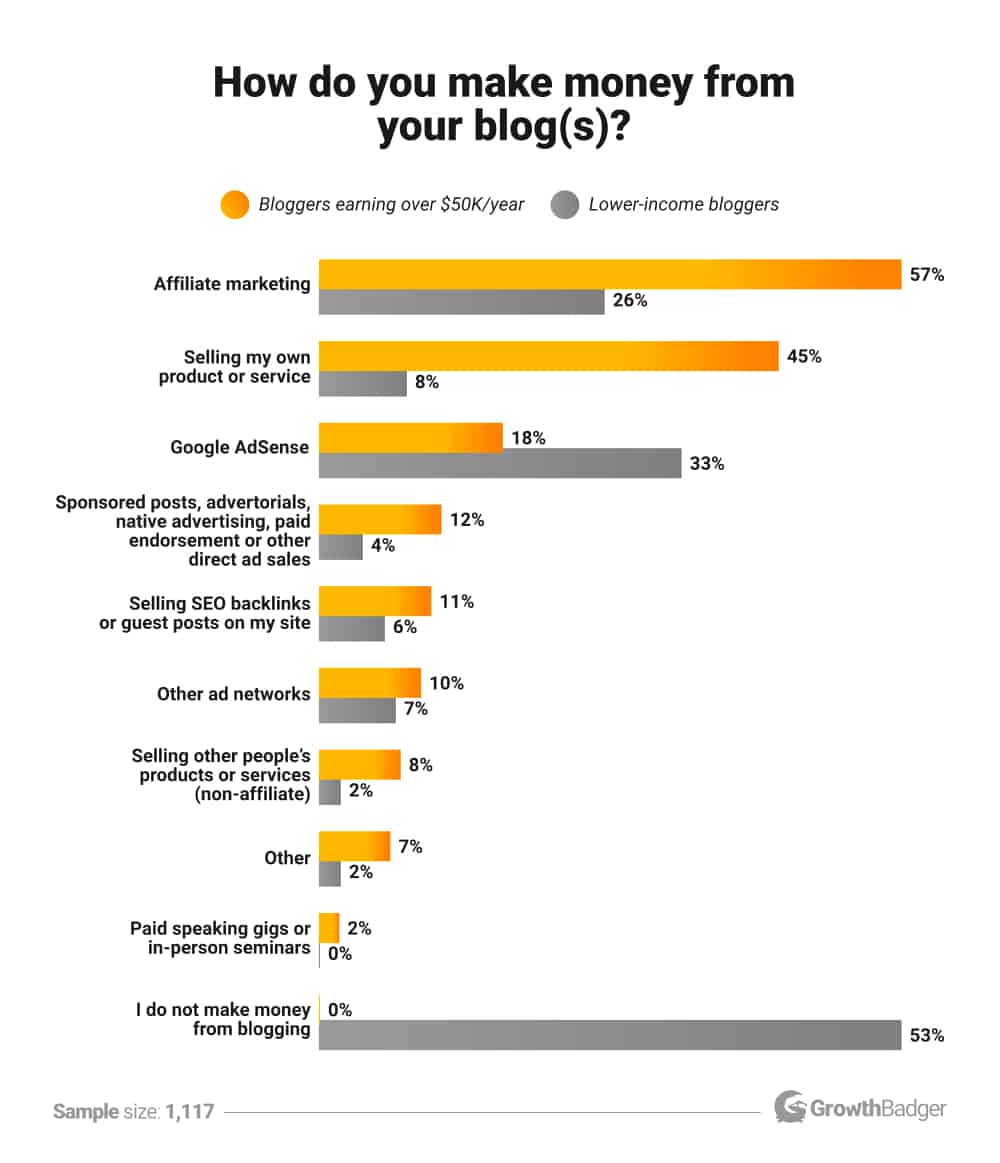
A little less than half of the lower-income bloggers we surveyed actually make money from their blogs.
Of the 47% that do, the most popular monetization methods by far are Google AdSense (33%) and affiliate marketing (26%).
Both of those methods are also popular with higher-income bloggers, but a much larger proportion of higher-income bloggers sell their own product or service compared to lower-income bloggers.
Major takeaway:
- Bloggers who earn over $50,000 per year from their blogs are 5.6 times as likely to sell their own product or service as bloggers who earn less.
- Higher-income bloggers are also significantly more likely to use affiliate marketing, native advertising or other direct ad sales, or to sell other people’s products and services in a non-affiliate way (for example, ecommerce/online shopping).
What Are the Biggest Challenges with Blogging?
While lower-income bloggers tend to say they have more challenges with their blogs, the top three difficulties are the same among both income levels.
 Major takeaways:
Major takeaways:
- The most common challenge for all bloggers is getting blog traffic or growing their audience.
- Bloggers who earn less than $50,000 per year are 4.2 times as likely to have difficulty with self-discipline and motivation compared higher-income bloggers.
Shrinking Blog Readership and Traffic from Google and Facebook: Is It Getting More Difficult to Run a Successful Blog?
It’s been reported that organic traffic from Google and Facebook is getting harder to come by, but how much is the average blogger feeling it?
And are people spending less time reading blogs in general?
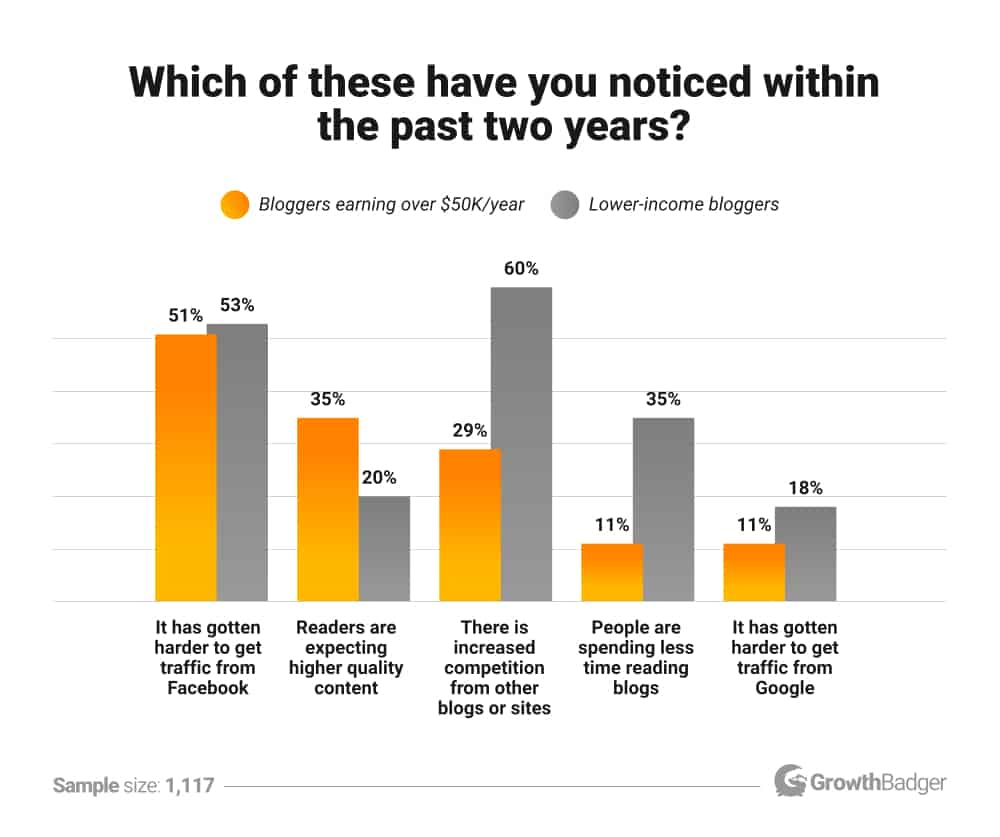
Major takeaways:
- Over 50% of all bloggers say it has gotten harder to get traffic from Facebook in recent years. This makes sense since there has been a significant decline in organic reach there.
- 35% of bloggers earning over $50,000 per year say readers are expecting higher quality content now than they were two years ago.
- Despite some theories to the contrary, most bloggers did not say they’ve noticed that people are now spending less time reading blogs.
Why Do Bloggers Blog?
Motivation can be very important. With this question, we wanted to see if there were any major differences between the motivations of higher-income and lower-income bloggers.
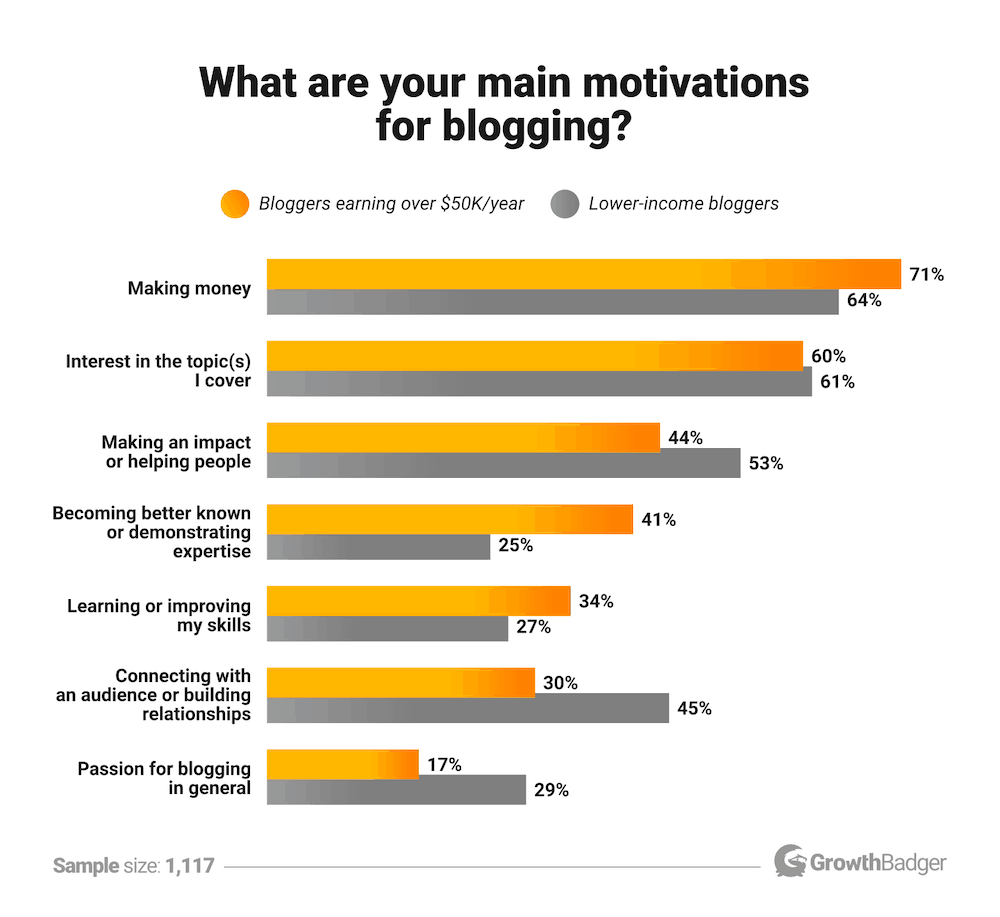
Major takeaways:
- Making money is the most common reason people blog, followed by interest in the topic.
- Compared to lower-income bloggers, bloggers who earn over $50K per year are 64% more likely to be motivated by a desire to become better known or demonstrate expertise, and 26% more likely to blog in order to learn or improve their skills.
- Most bloggers do not say they are motivated by a general passion for blogging.
Expert opinion:
Jon Morrow, CEO of Smart Blogger
“What’s interesting about the “make money” motivation is it actually covers three distinct audiences: people hoping their blog turns into a lifestyle business, people hoping to get paid to write, and people already running a business and hoping their blog brings in clients. You can’t really group them together, because it’s different ‘jobs to be done.’
The tactics employed by each group are also quite a bit different from each other. For example, someone who is building a lifestyle business might focus on generating search engine traffic and passive income through affiliate marketing, while a freelancer might focus on guest posting and building authority through case studies and interviews.”
Conclusion and Bonus Chart: What Successful Bloggers Do Differently
It would be foolish to look at the charts above as a checklist of blogging trends that everyone should follow in order to be successful.
After all, these statistics are based on correlation, not causation.
Adopting any of these techniques too early or in the wrong scenario may even make a blog less likely to succeed. For example, unprofitable blogs will probably only become more unprofitable if they start using paid promotion.
However, many of these techniques are strongly correlated with higher earnings.
So they’re worth considering as solutions for the challenges you may face.
Rather than merely looking at them individually, you may also notice how they work together:
Your outsourced content isn’t doing well?
Maybe you should try a) hiring better writers to b) write longer posts that are c) more narrowly aimed at your specific target audience.
The key is to think about how these techniques may fit in with the stage your blog is at, as well as what you are trying to accomplish.
Now, click here for a bonus chart of the top things that successful bloggers do differently (factors which are very correlated with higher income) and a PDF of this full report.
Study Details and Method
Thanks to our supporters, Kinsta WordPress hosting and Mangools SEO tools, who helped bring in the 1,117 respondents that made this blogging study possible.
We conducted this study as an online survey in February 2019 and received responses from 1,117 people who self-identified as bloggers — the majority of whom were U.S.-based. The results published here have a 2.9% margin of error with 95% confidence, based on an estimated global population of between 50 million and 300 million active bloggers (it’s unknown how many worldwide bloggers there are for certain, but there are an estimated 31 million in the U.S.).

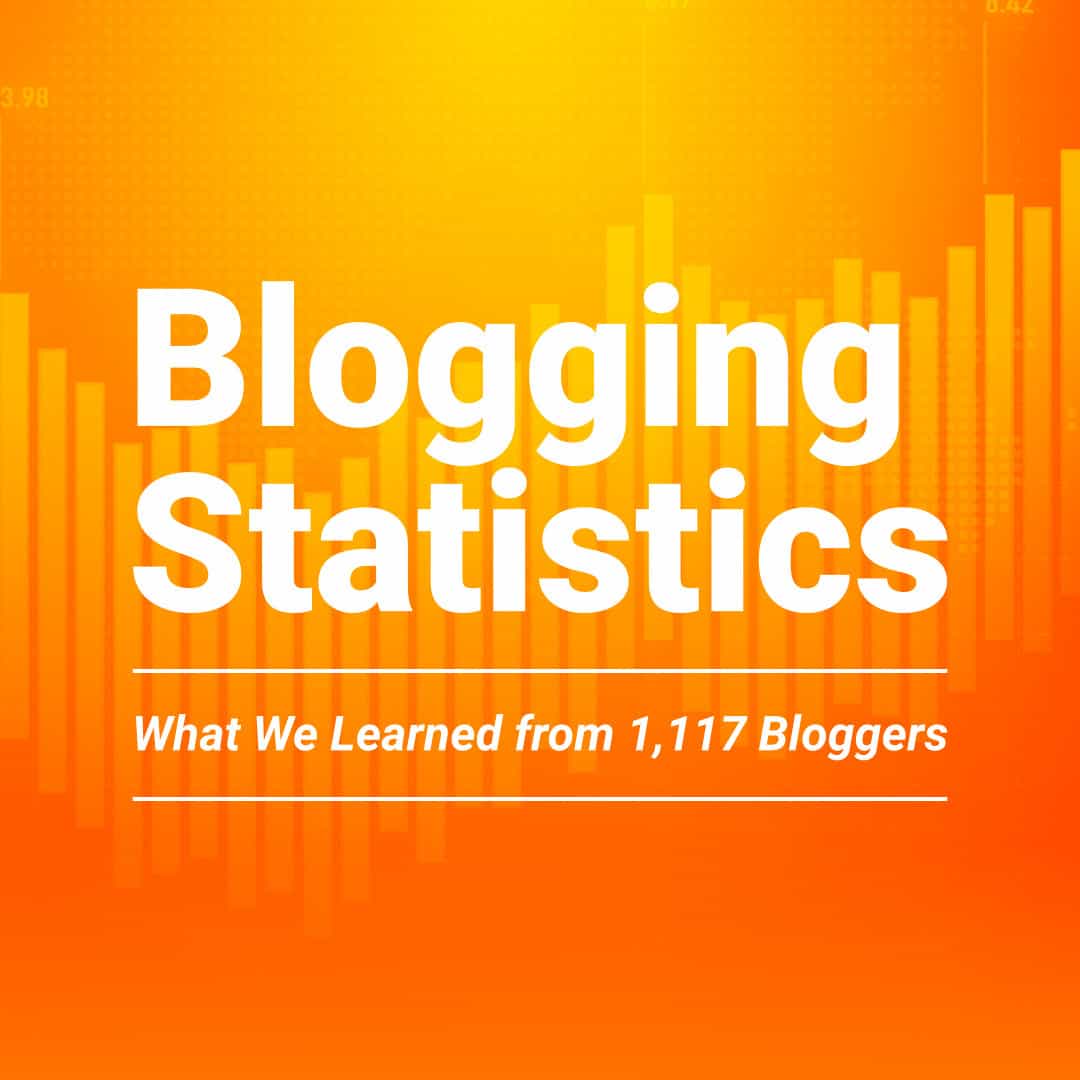
This is really interesting, thanks for taking the time to put this together Kyle :).
I find the fact that only 15% of lower-income bloggers do keyword-research shocking. I started doing keyword-research as soon as I created my blog French Together and honestly think it’s one of the main reasons I now earn a full-time income from my blog. The difference between an article written randomly and an article written after a good amount of keyword-research (and research in general) is huge for me.
What I have noticed over the years is that higher-income bloggers tend to be much more methodic. They take the time to research topics, understand their readers and tend to choose a strategy and take the time to implement it while lower-income bloggers often switch tactics.